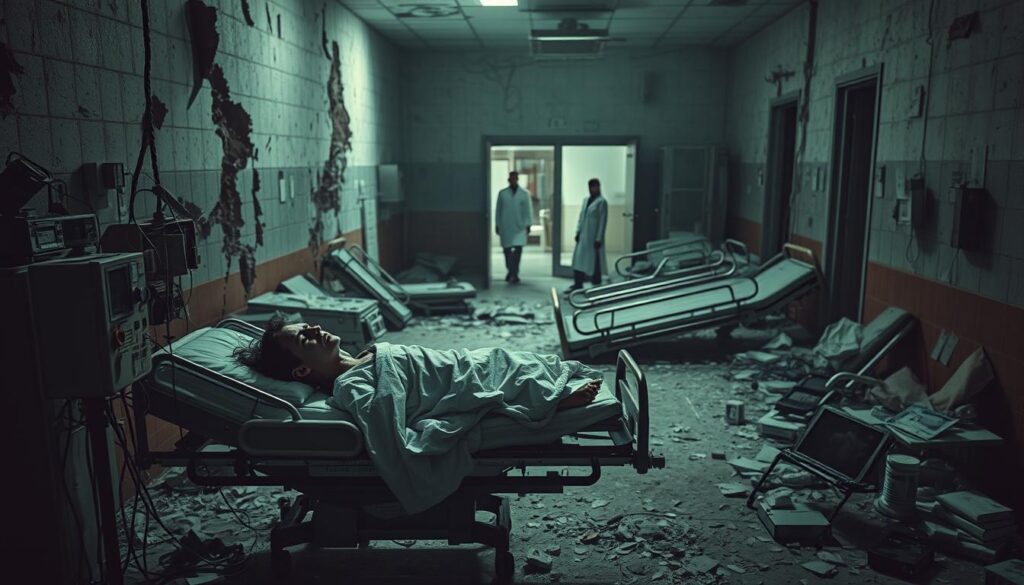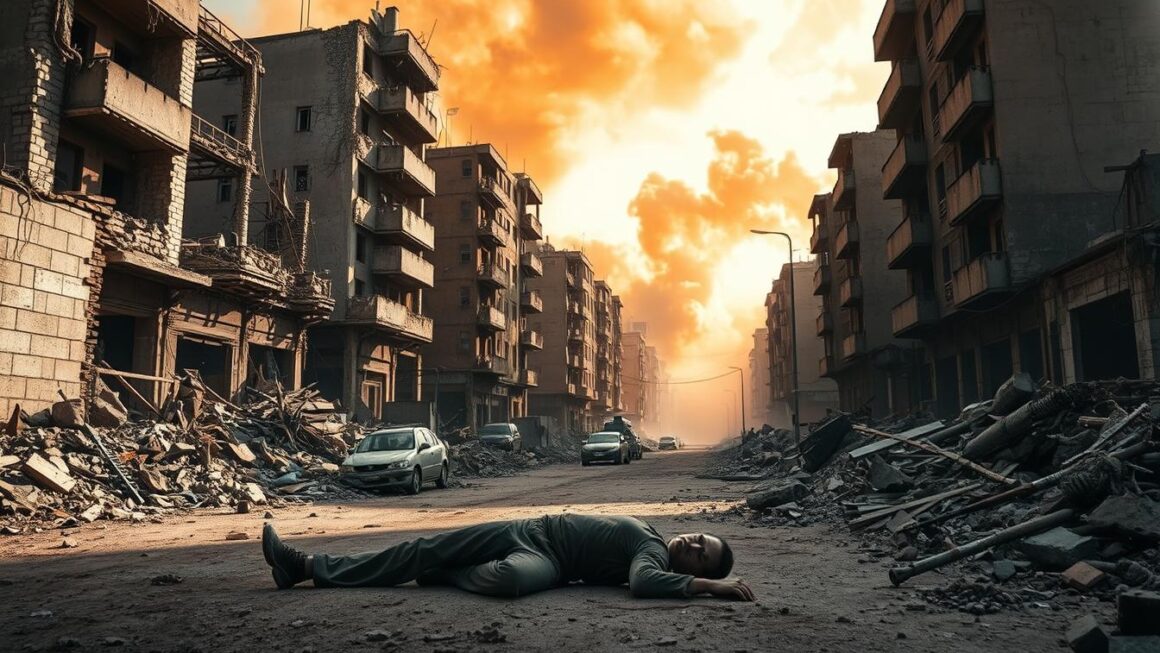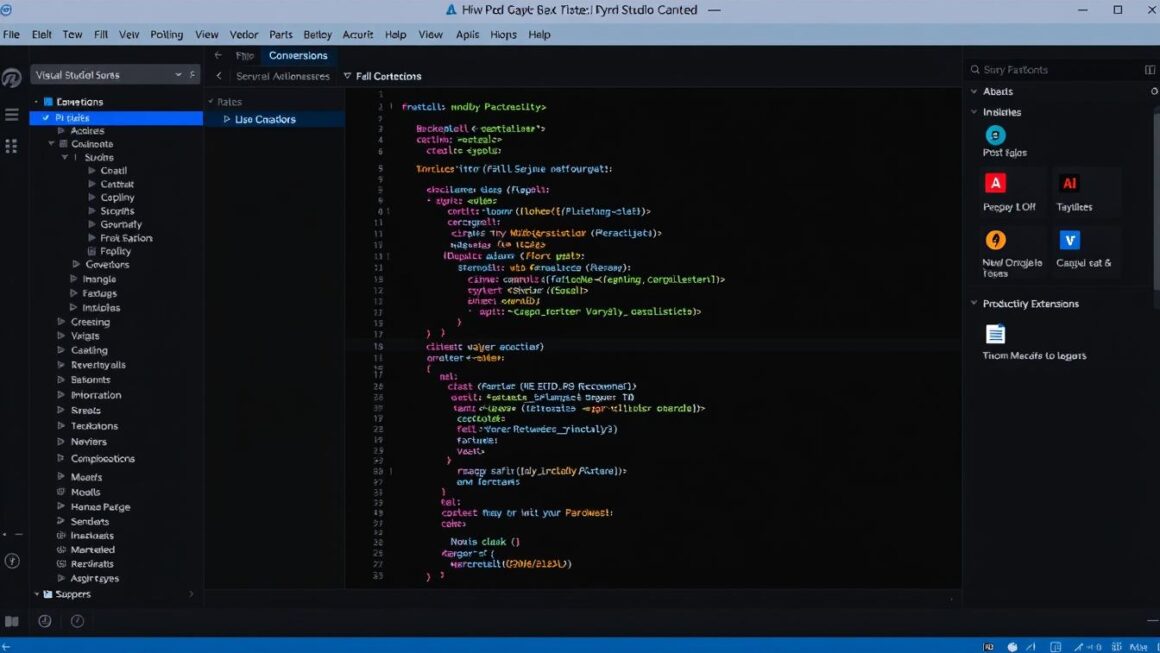What if the next global conflict doesn’t look like the wars we’ve seen before? With rising tensions and advanced technology, modern warfare could reshape life as we know it. Unlike past battles, today’s threats include cyberattacks, AI-driven weapons, and economic warfare—putting people at greater risk than ever.
Recent events, like NATO-Russia standoffs and Middle East instability, show how quickly tensions escalate. The UN reports over 12,700 nuclear warheads exist worldwide. A single strike could devastate entire cities, making traditional battlefields obsolete.
Experts warn that civilians would face the harshest blows. Infrastructure, food supplies, and communication networks could collapse first. Many are already preparing—gas masks and KI tablets are now grim necessities. The question isn’t if we’re ready, but how we adapt.
Key Takeaways
- Modern conflicts involve cyber warfare and AI, changing how wars are fought.
- Global tensions, like NATO-Russia disputes, increase the risk of escalation.
- Nuclear threats remain a critical danger, with thousands of warheads active.
- Civilians face unprecedented risks, from infrastructure collapse to supply shortages.
- Preparation, like emergency kits, is becoming a reality for many.
Introduction: The Looming Shadow of World War 3
Modern dangers make past conflicts look simple by comparison. Unlike the trenches of WWI or the bombings of WWII, today’s threats blend technology, politics, and environmental crises. The 2025 Global Peace Index warns of a 23% surge in active conflict zones since 2010—proof that instability is spreading.
In 1914, nations took weeks to mobilize. Now, hypersonic missiles strike in minutes. The Pentagon’s 2023 wargame predicted 90 million casualties in 36 hours. Civilians, not soldiers, would bear the brunt—modern projections suggest 85%+ deaths, up from 66% in WWII.
Nuclear safeguards are crumbling. New START expired, while Iran enriches uranium beyond treaty limits. The 2024 Riyadh summit failed to halt Gaza fighting, proving diplomacy’s fragility. Polish PM Tusk’s 2025 warning of “real risk” echoes NATO’s 1950 containment strategy—but today’s stakes are higher.
- Compound crises: Climate disasters + AI weapons + existing tensions create a perfect storm.
- Speed kills: Cyberattacks disable infrastructure faster than air raids ever could.
- No safe zones: Economic warfare means your savings could vanish overnight.
The future of warfare isn’t just about bombs. It’s about surviving in a world where the rules no longer apply.
How WW3 Would Differ from Past Global Conflicts
Forget bullets and bombs; modern warfare targets bank accounts and power grids. Today’s conflicts blur lines between physical and digital, turning systems we rely on into weapons. The rules have changed—and so have the risks.
Cyber Warfare: The Invisible Battlefield
A single hack could paralyze hospitals or shut down stock markets. In 2022, Russian sanctions triggered SWIFT exclusions, freezing $300B in reserves overnight. Cyberattacks don’t just steal data—they erase trust.
AI and Autonomous Weapons: War Without Human Control
Drones now decide targets faster than humans can react. China’s SMIC foundries stalled when chip sanctions hit, proving tech is a battleground. When machines fight, who’s accountable?
Economic Sanctions as Weapons of Mass Disruption
The CHIPS Act showed how nations weaponize the economy. In 2024, Saudi Arabia’s petroyuan shift rocked oil markets. Meanwhile, alliances like BRICS explore gold-backed currencies to bypass the dollar.
- Ruble rollercoaster: Russia’s 2022 currency crash (58→139→52 vs USD) revealed sanction power.
- Resource nationalism: India-Pakistan’s 2025 Indus Waters clash proved water is now a weapon.
- Hyper-globalization risks: One blockade can starve supply chains for months.
This isn’t your grandfather’s war. It’s faster, quieter, and far more personal.
The Immediate Impact of World War 3 on Daily Life
Grocery store shelves empty faster than we realize. Modern conflicts don’t just destroy buildings—they erase the systems keeping our lives running. Within days, digital networks could fail, and food supplies might vanish.
Collapse of Digital Infrastructure: A Connected World Goes Dark
Imagine waking up to no internet, no banking, and no way to call for help. Cyberattacks on power grids could leave cities in darkness for weeks. In 2022, Ukraine’s grain exports stalled after Russian hackers targeted port logistics—a preview of global disruption.
Critical services rely on fragile digital chains:
- Hospitals lose access to patient records.
- ATMs and credit cards stop working.
- Supply trackers fail, worsening shortages.
Food and Water Shortages: From Abundance to Scarcity
Fertilizer shortages hit harder than most expect. Ammonia isn’t just for crops—it’s used in CO2 production for refrigeration. No ammonia means spoiled food, even if shelves were stocked.
Climate disasters amplify the crisis. The 2025 Mekong drought cut rice yields by 30%, forcing countries like Thailand to ration exports. Cape Town’s “Day Zero” water crisis showed how metros might ration taps.
Global breadbaskets are at risk:
- 55% of wheat comes from conflict-prone regions.
- Nestlé’s 2024 report warned of 6-month reserve limits.
- Desalination plants, vital for security, are drone targets.
We’re one blockade away from empty pantries.
Energy Crises and the Breakdown of Supply Chains
Lights flicker, then vanish—modern wars strike where we least expect. Unlike battlefields, today’s conflicts target oil routes, lithium mines, and the power grids keeping hospitals running. When these systems fail, the global economy stumbles.
The Strait of Hormuz proves how fragile supply lines are. Nearly 30% of the world’s oil passes through this narrow channel. Houthi drones could blockade it in hours, spiking gas prices globally. Energy isn’t just fuel; it’s leverage.
Texas’s 2021 grid collapse showed another weakness. Frozen pipelines left millions without heat. Now imagine cyberattacks disabling smart grids nationwide. Without control over energy, cities darken within days.
“Semiconductor-grade neon, vital for chip production, once came solely from Mariupol plants. The 2024 EU Critical Raw Materials Act lists 34 minerals now deemed ‘strategic’—proof that shortages rewrite rules.”
Companies relying on *just-in-time* inventory face disaster. The 2025 Congo cobalt war disrupted battery production for months. Switching to *just-in-case* stockpiles might save critical areas, but costs soar.
- Oil reserves release too slowly—strategic petroleum stocks last weeks, not years.
- Lithium dependence ties green energy to unstable regions like the Congo.
- Smart grids boost efficiency but hack like any connected system.
We built a world where efficiency trumps resilience. The next crisis will test which one truly matters.
World War 3 Consequences for Employment and Economies
Money loses meaning when markets crash overnight. Financial systems, once stable, can collapse under the weight of global war. Jobs vanish, pensions evaporate, and currencies become worthless paper—leaving people scrambling for survival.
The Domino Effect of Global Market Collapse
One shock can trigger a chain reaction. When Russia defaulted in 2022, European factories halted due to missing parts. The 2025 Zimbabwe ZiG currency launch proved even new money can’t stop hyperinflation.
Key vulnerabilities in modern economy:
- Pension funds mismatched: Rising rates crushed long-term bond values.
- Stablecoin traps: Government backdoors could freeze digital savings.
- Supply chain failures: Just-in-time systems lack crisis buffers.
| Crisis | Inflation Peak | Recovery Time |
|---|---|---|
| Weimar Germany | 29,500% (1923) | 6 years |
| Argentina 2023 | 140% | Ongoing |
| Hypothetical 2025 | 300%+ | Unknown |
Hyperinflation and the End of Financial Security
El Salvador’s 2024 Bitcoin move showed nations seeking alternatives. But when trust in institutions fails, communities create their own systems. Italy’s Sardex network traded $150M in local credits during banking crises.
Three survival strategies emerge:
- Barter networks: Skills and goods replace cash.
- Cryptocurrency: Decentralized but volatile.
- Local currencies: Backed by community trust.
“When ATMs dispense worthless bills, people return to gold jewelry and canned food as currency—just like in 1990s Yugoslavia.”
Financial security isn’t about money anymore. It’s about having what others need when systems fail.
Healthcare Systems Under Siege

Hospitals could become battlegrounds without a single soldier stepping inside. Modern medicine relies on fragile systems—from power grids to supply chains. One electromagnetic pulse (EMP) could disable 90% of ICU equipment in seconds.
The 2025 WHO radiation protocols warn that X-ray machines and pacemakers are vulnerable. Backup generators often have just 72 hours of fuel. When that runs out, dialysis patients and premature babies face immediate danger.
Medicine shortages hit hardest. Over 80% of active pharmaceutical ingredients (APIs) come from conflict-prone regions. Insulin production clusters in only three countries, leaving diabetics at risk if trade routes close.
Ukraine’s 2023 evacuation of dialysis patients showed the human cost. Over 300 people needed emergency transfers when attacks cut power to clinics. Meanwhile, Cuba’s “medical isolation” model—local vaccine production and stockpiled generics—proves resilience is possible.
New threats emerge from labs. CRISPR gene-editing tools, meant to cure diseases, could be weaponized. The 2024 Global Bio-Risk Report found 17 nations now have dual-use biotech programs. Security gaps in these facilities could unleash engineered pathogens.
We’ve built healthcare on just-in-time deliveries and thin margins. The next crisis won’t just overwhelm hospitals—it will erase the advances we take for granted.
The Psychological Toll of Living in War’s Shadow
Fear rewires minds faster than bullets destroy cities. Even without direct violence, the anticipation of conflict leaves deep scars. The 2025 Edelman Trust Barometer shows record lows in faith in institutions—proof that uncertainty breeds skepticism.
Generational Trauma: Anxiety as the New Normal
Children raised in crisis adopt survival instincts as default settings. Studies link prolonged stress to altered brain development. Hyper-vigilance becomes hereditary, passing down like an unwanted heirloom.
Rwanda’s post-genocide reconciliation offers hope. Their community courts rebuilt trust through dialogue. Yet, cognitive closure—the need for definitive answers—fuels radicalization elsewhere. When answers are scarce, conspiracy theories thrive.
The Erosion of Trust in Systems and Each Other
Signal and Telegram groups replace news outlets in conflict zones. The EU’s 2024 Digital Services Act struggles to curb misinformation. Vaccine hesitancy patterns now mirror wartime rumor spreads—both exploit gaps in security.
- Local networks collapse when neighbors suspect each other.
- Authority challenges spike as survival instincts override order.
- Control shifts to whoever provides basic needs first.
“In crisis, people don’t lose faith in systems—they lose faith in the idea that systems can protect them.”
We’re wired to seek safety. When institutions fail, tribes form. The real casualty of war isn’t just lives—it’s our shared sense of reality.
Forced Migration on an Unprecedented Scale
Borders slam shut as millions flee—forced migration reshapes nations overnight. The 2025 UNHCR projection warns of 300 million displaced people, dwarfing the Syrian crisis. Unlike past flows, new threats like biometric tracking and AI border systems complicate escape.
Europe’s 2024 AI-powered fences scan faces in seconds, denying entry to those from high-risk areas. Meanwhile, temporary camps face malaria resurgences—a grim echo of 2015’s Za’atari outbreak. Safety is no longer a place; it’s a loophole in the system.
Climate disasters amplify the chaos. Bangladesh’s 2024 “climate refugee” visa offered a lifeline to 10,000—but what happens when coastal cities sink globally? Dubai’s 3D-printed refugee housing pilot shows innovation, yet scales too slowly.
- Financial traps: Crypto remittances face censorship as countries block transfers to conflict zones.
- Urban strain: Cities like Istanbul and Bogotá buckle under waves of arrivals.
- Legal limbo: Post-war instability leaves many stateless for decades.
“We built walls to keep threats out—now they trap people inside disaster zones.”
Migration isn’t just movement. It’s the collapse of home, rewritten in real time.
Nuclear Threats and the Reality of Mutually Assured Destruction
Silent and invisible, radiation lingers long after the blast fades. Unlike conventional warfare, nuclear weapons leave scars that span generations. A 2023 Rutgers study modeled India-Pakistan exchanges, revealing even regional conflicts could trigger global famine.
Fallout Effects: Radiation’s Long-Term Legacy
Strontium-90 embeds in bones; cesium-137 contaminates soil for years. Chernobyl’s exclusion zone remains uninhabitable decades later. Modern cities lack Soviet-style concrete shelters, leaving millions exposed.
The Svalbard Global Seed Vault, designed to safeguard crops, holds only 1.5 million samples. A full-scale exchange could outpace its capacity, erasing biodiversity backups we rely on.
Nuclear Winter and Global Climate Catastrophe
Soot from burning cities blocks sunlight, dropping temperatures by 5°C in models. Vertical farms might offset some losses, but acid rain would poison reservoirs. DARPA’s 2024 “Food in the Dark” program explores algae-based nutrition as a stopgap.
- 1°C drop: Wheat yields fall 10%; 5°C collapses entire growing seasons.
- Ocean collapse: Phytoplankton die-offs disrupt the marine food chain.
- Synbio solutions: Engineered microbes could recycle waste into protein.
“We’ve built a world where one button press unravels the climate balance of millennia.”
Mutually assured destruction isn’t just about explosions. It’s about surviving the silent aftermath—where hunger and cold claim more lives than the blast itself.
The Role of Social Media and Misinformation in Escalation
Algorithms now shape conflicts faster than diplomats can react. A 2024 Kenyan election deepfake showed a candidate “resigning”—sparking riots within hours. Today’s battles aren’t just fought with weapons; they’re waged in feeds and forums.
OpenAI’s GPT-5 struggles to flag hate speech in dialects, while TikTok bans in conflict zones reveal how platforms lose control. Encrypted apps like Signal let militaries coordinate off-grid, bypassing institutions entirely.
Blockchain fact-checking projects aim to restore trust. The EU’s 2025 Digital Services Act forces platforms to label state-backed propaganda. Yet loopholes remain—WeChat’s Taiwan info ops prove tech giants can’t police every channel.
- Zero-day exploit black markets: Hackers sell vulnerabilities to the highest bidder, whether governments or rebels.
- Algorithmic radicalization: Recommender systems push extreme content to keep people engaged.
- Deepfake arms race: Tools to detect fakes lag behind those creating them.
“A lie circles the globe while truth puts on its shoes. In war, that gap costs lives.”
We’ve built tools to connect, but they’re being weaponized. The next crisis may start with a tweet, not a treaty.
Lessons from History: Why Diplomacy Matters More Than Ever
History whispers warnings we ignore at our peril. From Syria’s collapse to Yemen’s famine, recent conflicts show how quickly localized fights spiral. The 2025 Congo cobalt war proved even resource disputes can drag in global nations—when mines became battlegrounds, electric car factories stalled worldwide.
Cold War Close Calls: Brinkmanship and Its Dangers
We nearly missed nuclear war in 1962—and again in 1983. Soviet officer Petrov’s refusal to launch saved millions when radar glitches falsely showed US missiles. Today’s automated systems leave even less reaction time.
Power games haven’t disappeared. The 2025 Saudi-Iran thaw stalled after drone strikes, mirroring 1980s US-Soviet proxy fights. When countries test limits, accidents happen.
Proxy Wars and the Slippery Slope to Global Conflict
Wagner Group’s 2024 Sahel operations followed old playbooks—deniable troops, mined resources. But crypto payments changed the game. Monero transactions circumvented arms sanctions, funding conflicts silently.
- Drone dominoes: Ethiopian rebels used Turkish Bayraktars, copied by Somali factions within months.
- Arms race math: Ukraine received Javelins in weeks; Syria waited years for TOW missiles.
- Digital fronts: Yemen’s Houthis now hack ships using leaked Iranian cyber tools.
“The 2015 Yemen war began with one president’s flight—and became a decade of starvation.”
We’ve seen how small fires become infernos. The next crisis won’t wait for diplomats to catch up.
Building Societal Resilience Against War’s Worst Effects

Resilience isn’t just stockpiling supplies; it’s weaving trust into every neighborhood. When systems fail, people relying on each other become the ultimate safety net. From urban block watches to rural cooperatives, local bonds outlast even the darkest crises.
Community Preparedness: Local Solutions for Global Crises
Rwandan unity schools show how shared spaces heal divides. After the genocide, mixed classrooms rebuilt trust—one lesson at a time. Today, similar models thrive in Bosnia, where history textbooks now include all perspectives.
Grassroots networks excel where institutions lag. The 2024 Nobel Peace Prize honored Kenyan mediators who stopped ethnic violence using WhatsApp groups. Their tools? Dialogue circles and real-time rumor tracking.
- Virtual reality empathy labs: Stanford’s 2025 study showed VR reduces prejudice by 40% after simulated refugee experiences.
- Restorative economies: Colombia’s ex-combatants now farm coffee alongside victims, turning war scars into shared livelihoods.
- “Peace tech” startups: AI predicts conflict hotspots by analyzing social media tension spikes.
Peace Education: Cultivating a Culture of Conflict Resolution
UNESCO’s 2025 global citizenship push embeds mediation into math and science classes. Students solve equations alongside mock peace treaties—proving STEM and diplomacy intersect.
“We won’t eliminate conflict, but we can teach the next generation to navigate it without violence.”
Norway’s “Future” curriculum assigns historical roleplays: Kids debate the Cuban Missile Crisis as Kennedy and Khrushchev. The goal? Understanding motives, not memorizing battles.
Change starts small. A single school teaching active listening becomes a town that de-escalates tensions. That town inspires a region—and soon, peace isn’t an abstract ideal. It’s daily practice.
The Power of Global Cooperation in Preventing WW3
Bridges between nations hold stronger than walls ever could. The 2025 Summit of the Future reshaped how world leaders tackle crises—from nuclear threats to climate collapse. Instead of isolation, the focus shifted to shared security through tech treaties and resource pools.
IAEA’s nuclear fuel bank, launched in 2024, now stocks uranium for 30+ countries. This prevents shortages that might spark conflicts. One reactor’s fuel is another’s bargaining chip. COP29’s loss and damage fund similarly ties climate aid to conflict prevention, targeting fragile regions first.
The Artemis Accords expanded to 42 signatories, including rivals like China and India. By standardizing moon mining rules, they reduce space-based tensions. Here’s how key alliances compare:
| Alliance | Focus | Members |
|---|---|---|
| QUAD | Indo-Pacific stability | US, Japan, India, Australia |
| AUKUS | Tech/military sharing | US, UK, Australia |
| BRICS | Economic alternatives | Brazil, Russia, India, China, South Africa |
Breakthroughs like the 2024 BWC Verification Protocol show progress. For the first time, biolabs must allow surprise inspections. The Open Skies Treaty revival talks also gained momentum, with drones replacing spy planes for transparency.
“We’re not just avoiding war—we’re building the tools to make it obsolete.”
True peace isn’t passive. It’s the daily work of sharing data, resources, and trust. From nuclear fuel to space rocks, cooperation turns threats into shared projects. That’s how we’ll prevent the unthinkable—together.
Why Common People Are the Frontline in Modern Warfare
Your phone could be the newest weapon in modern conflicts. Today, civilians report troop movements faster than satellites can track them. Ukrainian farmers towing tanks with tractors showed how ordinary people rewrite war rules.
The Diia app turned 18 million Ukrainians into intelligence gatherers. Locals upload photos of suspicious activity, creating real-time defense maps. This crowd-sourced system spots threats hours before official channels.
Belarusian railway partisans hacked train systems to slow Russian supplies. Using basic coding skills, they disrupted logistics without firing a shot. Cyber resistance proves you don’t need uniforms to fight.
Taiwan’s “Every Citizen a Sensor” program trains shopkeepers to spot drones. NATO’s 2025 guidelines now include grocery stores as early warning posts. When war comes, bus drivers and baristas become the first line of defense.
“Starlink dishes help refugees flee—and rebels coordinate attacks. Technology doesn’t choose sides.”
Crypto wallets let people impose “citizen sanctions” by freezing transactions to conflict zones. The world learned: power isn’t just in missiles. It’s in the hands of those who live where battles rage.
Conclusion: Choosing Peace Over Perpetual Preparedness
Costa Rica’s 1949 choice to abolish its military proved peace is possible. Without armies, they invested in education and healthcare—a model that still thrives today. The 2024 Vatican encyclical on AI ethics echoes this: true security comes from ethics, not escalation.
Grassroots pressure works. The 1982 NYC nuclear freeze rally drew a million people, shifting policies. Now, “peace bonds” fund diplomacy instead of weapons. The 2025 Nobel Committee’s “Preventive Peace” focus rewards such foresight.
Hiroshima survivors remind us: war leaves scars no preparedness heals. Their testimonies urge us to build a future where dialogue replaces destruction. In this fragile world, our best defense is choosing each other.



